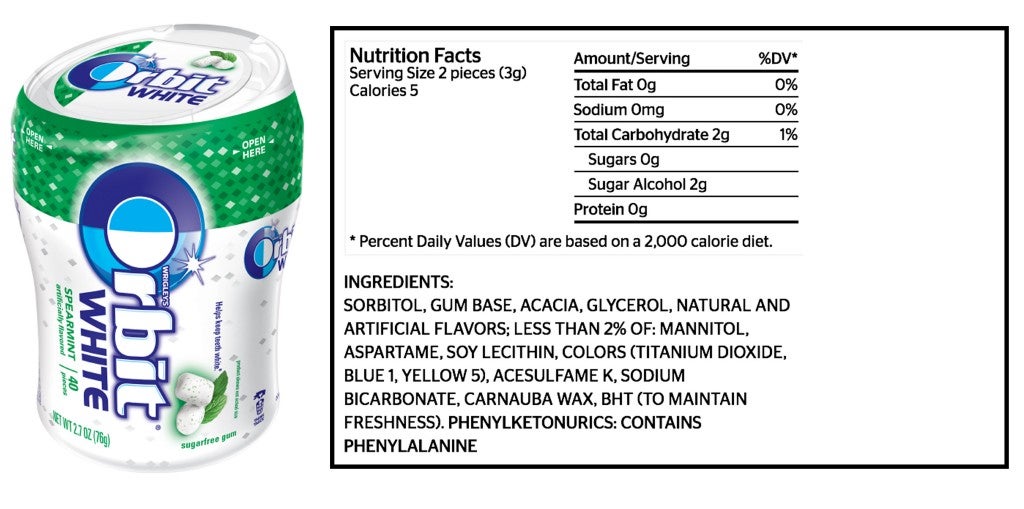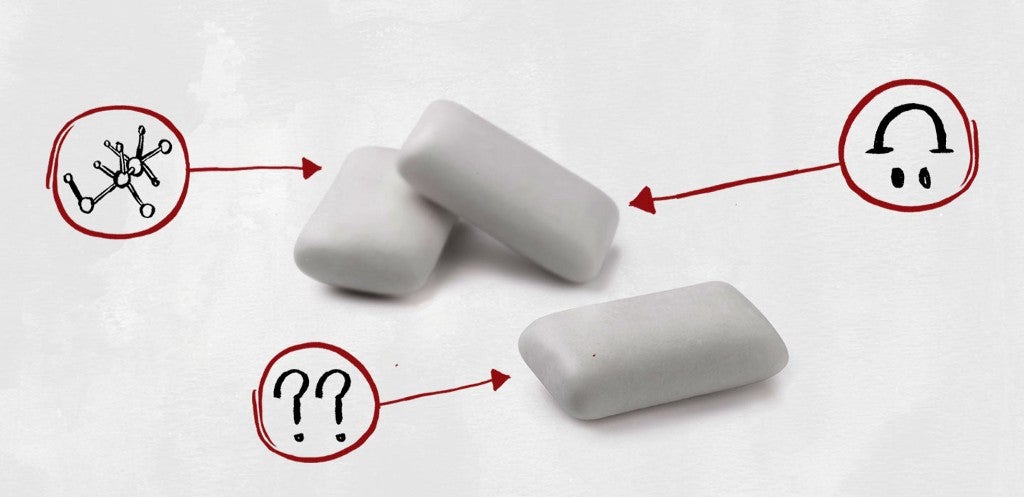We’re often told that you should never eat anything if you don’t recognize everything on the ingredients list. But since most of us have no idea what xanthan gum or potassium benzoate are — or more importantly, what they’re doing to our bodies — we’re decoding the ingredients in the many things Americans put in (and on) themselves with the help of an expert. This edition: Orbit White Spearmint Gum, which is made from 12 separate ingredients that we’ve broken down in the exact order they appear on the container.


The Ingredients
1) Xylitol: Xylitol is a sugar alcohol (an organic compound derived from plants) often used as a sweetener in sugar-free products. This is mainly due to the fact that it’s less caloric than real sugar, since the body can’t fully absorb and metabolize it (or the calories in it).
Xylitol is also better for your teeth than real sugar, according to a study published in the Journal of Dental Education: “The replacement of sucrose with sorbitol [which we’ll touch on shortly] and xylitol may significantly decrease the incidence of dental cavities.” That’s because, again, xylitol can’t be metabolized by the plaque attempting to make a home of your mouth. (Sugar, on the other hand, is a popular fodder for these cavity-causing assholes.)
Dog owners beware, though: “Xylitol can be toxic to dogs even in relatively small amounts,” notes Dagan Xavier, ingredient expert and co-founder of Label Insight. So make sure your pup doesn’t tear into your stash of gum.
2) Gum Base: Think of gum base like a sponge: It’s a chewy, indigestible, water insoluble compound used to transport sweeteners, flavors and whatever other substances gum makers decide to pack it with. While the actual composition of gum base is a trade secret — the FDA allows 46 different chemicals under the umbrella of “gum base” — it’s usually made from a combination of synthetic and natural ingredients. Synthetic resin, for instance, oftentimes makes up the main chewable portion, wax (Orbit White Spearmint Gum uses carnauba wax, which we’ll touch on shortly) softens the gum and elastomers add flexibility.
3) Natural and Artificial Flavors: These are the culprits behind the minty flavor. While natural flavors are literally flavors derived from an actual food source — i.e., mint flavoring taken from a real mint plant — artificial flavors are chemical compounds created in a lab that mimic a natural flavor in some way. While that may sound unhealthy, as physician and biochemist Cate Shanahan, author of Deep Nutrition: Why Your Genes Need Traditional Food, told us during our exploration of all 26 ingredients in nacho-flavored Doritos, these flavorings are added in such minute quantities that they shouldn’t cause you any harm.
4) Acacia: Acacia is a large genus of shrubs, lianas and trees. The secretions from these plants are typically turned into a gum, which can be used as a bulking agent, emulsifier, stabilizer, thickener, foaming agent, gelling agent, suspending agent and whipping agent. In this case, it’s probably added to give the gum itself a gummier texture.
5) Aspartame: Aspartame is an artificial sweetener made primarily out of two amino acids (the building blocks of protein): aspartic acid and phenylalanine. It’s about 200 times sweeter than sugar, so much less of it is needed to achieve the desired sweetness — this, in effect, is why Orbit White Spearmint Gum and other comparable sugar-free gums, like Trident White Spearmint Sugarless Gum, have only five calories per serving: One piece of Double Bubble Gum, for comparison, contains 20 calories.
Unfortunately, as we learned in our exploration of the eight ingredients found in Diet Coke, several studies suggest that aspartame may actually promote weight gain despite being marketed as doing the very opposite (visit the link above for an in-depth explanation on how that works).
Additionally, Shanahan says that some people are so sensitive to the aspartic acid in aspartame that it causes them to experience headaches, dizziness and even confusion. In other words, steer clear of this ingredient when you can.
6) Soy Lecithin: Soy lecithin is a component of fat found in (you guessed it!) soy. It’s typically added to food products as an emulsifier. In simpler terms, it helps all the ingredients properly blend together. “It’s also frequently used to extend product shelf life,” Xavier adds. In our exploration of the eight ingredients found in Optimum Nutrition Gold Standard 100% Whey Powder, board-certified nutrition specialist Jason Boehm also noted that unless you have an extreme allergy to soy — which you’d know by now — soy lecithin isn’t anything to worry about.
7) Sorbitol: Extremely similar to xylitol, sorbitol is a sugar alcohol often used as a sweetener in lieu of actual sugar. Those with gastrointestinal conditions should watch out for this ingredient, however: Studies show that it’s an effective laxative and can cause diarrhea, bloating, gas and abdominal pain.
8) Acesulfame K: “Also known as Ace K or Acesulfame Potassium, Acesulfame K is a calorie-free sugar substitute that’s 200 times as sweet as sucrose [a common sugar],” Xavier explains. As we learned in our exploration of all eight ingredients in Optimum Nutrition Gold Standard 100% Whey Powder, recent rodent studies suggest that long-term consumption of acesulfame potassium may cause cognitive damage. That said, as with all rodent studies, further research is required to fully understand the effects this ingredient has on humans.
9) Coloring (Includes Blue 1): While certain artificial colors (blue 1 being one of them) are known to be carcinogenic, Shanahan assures us that a normal person’s liver should have no problem breaking down whatever miniscule amounts of coloring we consume with our food.
10) Sodium Bicarbonate: Better known as baking soda, sodium bicarbonate has been proven to reduce plaque when added to chewing gum.
11) Carnauba Wax: “Carnauba wax is a water insoluble substance used as a glazing, bulking and anticaking agent,” Xavier explains. “It’s commonly used in chewing gums to carry flavors.” This particular wax is sourced from the copernicia prunifera, a plant grown only in northeastern Brazil.
12) BHT (To Maintain Freshness): BHT is a common preservative added to prevent products from spoiling. Studies continue to go back and forth about whether or not it’s carcinogenic, but chances are you wouldn’t consume enough of it while chewing gum to cause you any harm.
The Takeaway
While Orbit White Spearmint Gum is packed with numerous harmful artificial sugars, it’s important to remember that they’re added in miniscule amounts and that you’re (hopefully) not actually swallowing the gum. As such, the likelihood that they’ll actually do you any harm is slim to none — even if you’re chewing on the stuff all day long. Instead, just be glad that this gum, according to studies, will keep your teeth the pearliest of whites.

